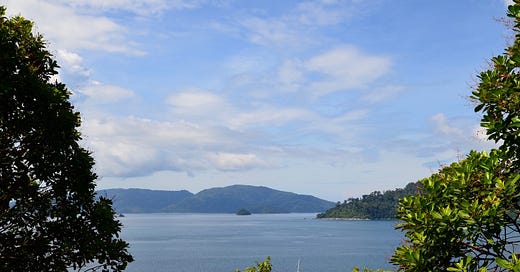T.I.C.D.: Mu Ko Adang & Ko Khai
The entire Adang archipelago and the Ko Khai group of islands, condensed.
Welcome back to the Thai Island & Coastal Directory, a book-in-progress that promises to be the most complete guide to coastal Thailand ever written in English, covering more than 800 islands. For info on how to use the T.I.C.D. and a working Table of Contents, paddle over here. Thank you for reading!
Resuming Satun province…
The islands of Mu Ko Adang comprise fully a quarter of Satun’s islands.
Mu Ko Adang
Also known as the Butang archipelago, Mu Ko Adang contains 26 islands located some 65 to 80 km southwest of the nearest mainland (at Pakbara). This distance makes them some of Thailand’s furthest-flung islands.
Only 40 km away is the large island of Pulau Langkawi, which is part of Malaysia. Mu Ko Adang’s location near the international sea border in the absolute southwest of Thailand certainly adds to its “out there” allure.
This remoteness does not mean that no one goes to Mu Ko Adang. Its best-known island, Ko Lipe, is by far the most popular island not only in Satun but also the entire Southern Andaman coastal zone. It’s also one of only 10 Thai islands that I place in the mass-tourism category. In the 1980s Lipe counted annual foreign tourist arrivals in the hundreds and some travelers who visited back then say the rapacious development that accelerated around 2010 has ruined this diminutive island. Still, Lipe remains spectacular along its beaches and away from the concrete and motorbikes which choke sealed lanes that used to be sandy foot trails.
Ko Lipe is however the only heavily developed island in an archipelago that is otherwise almost entirely undeveloped thanks to its inclusion in Mu Ko Tarutao NP. Founded as Thailand’s first marine park in 1974, it also includes the large island of Ko Tarutao, which combines with Mu Ko Adang and the Ko Khai group in what remains the largest and arguably best-known marine NP in the country. Add Mu Ko Bulon and Mu Ko Khao Yai, and you can see why Satun’s collection of islands stands right up there among the finest of all the coastal Thai provinces.
Among the islands that are fully controlled by the NP you have Ko Rawi and Ko Tong, both boasting some extraordinary unspoilt beaches in remote W points of the archipelago. The largest island is Ko Adang, whose only development apart from the NP facilities at Laem Son is a couple of modest villages housing indigenous Urak Lawoi people and one resort in the S overlooking Ko Lipe.
The marine park’s foundation did come at a hefty cost to the Urak Lawoi who have lived in Mu Ko Adang since 1910, if not earlier. Some of these traditionally semi-nomadic “sea people” established tourism businesses on Ko Lipe, but many remain stateless and often struggle to retain the rights to remain living on slices of an archipelago that was, for many decades, theirs to inhabit as they pleased. Today, most of the longtail boat drivers plying Mu Ko Adang are Urak Lawoi.
With at least 32 dive sites, Mu Ko Adang also ranks among Thailand’s most popular scuba zones. Non-diving boat tours are big business as well, mostly thanks to the veritable fleet of longtails that anchors around Ko Lipe.

Islands below arranged roughly from E to W.



